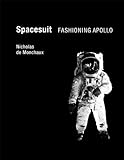Engineering and Couture: Fashioning Apollo
Science Friday on National Public Radio is a must for us. Ira Flatow and Joe Palca take us to other universes while explaining ideas, theories and innovations with the help of articulate scientists.
This morning was a trip with the makers of bras and girdles, Playtex, companions of many a girl and woman decades ago as well as present day. Here is a book by Nicholas de Monchaux, Spacesuit, that describes the journey the first spacesuits undertook to manufacture, test and use by United States astronauts.
When Neil Armstrong and Buzz Aldrin stepped onto the lunar surface in July of 1969, they wore spacesuits made by Playtex: twenty-one layers of fabric, each with a distinct yet interrelated function, custom-sewn for them by seamstresses whose usual work was fashioning bras and girdles. This book is the story of those spacesuits. It is a story of the Playtex Corporation’s triumph over the military-industrial complex — a victory of elegant softness over engineered hardness, of adaptation over cybernetics.
Playtex’s spacesuit went up against hard armor-like spacesuits designed by military contractors and favored by NASA’s engineers. It was only when those suits failed — when traditional engineering firms could not integrate the body into mission requirements—that Playtex, with its intimate expertise, got the job.
In 
Spacesuit: Fashioning Apollo by Nicholas de Monchaux, the author tells the story of the twenty-one-layer spacesuit in twenty-one chapters addressing twenty-one topics relevant to the suit, the body, and the technology of the twentieth century. He touches, among other things, on eighteenth-century androids, Christian Dior’s New Look, Atlas missiles, cybernetics and cyborgs, latex, JFK's carefully cultivated image, the CBS lunar broadcast soundstage, NASA’s Mission Control, and the applications of Apollo-style engineering to city planning.
The twenty-one-layer spacesuit, de Monchaux argues, offers an object lesson. It tells us about redundancy and interdependence and about the distinctions between natural and man-made complexity; it teaches us to know the virtues of adaptation and to see the future as a set of possibilities rather than a scripted scenario.
Nicholas de Monchaux is Assistant Professor of Architecture at the College of Environmental Design, University of California, Berkeley. His work has appeared in the architectural journal Log, the New York Times, the New York Times Magazine, Architectural Digest, and other publications.






